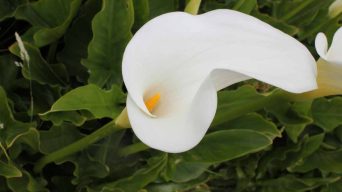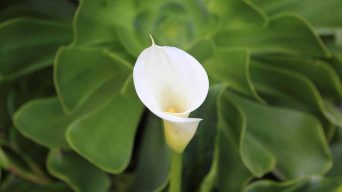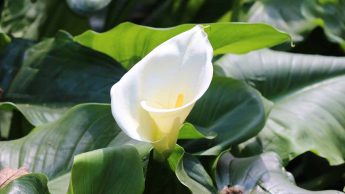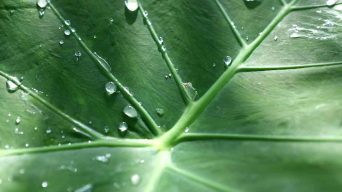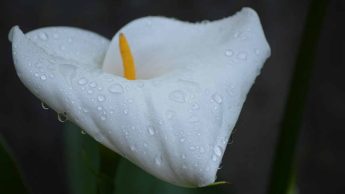Calla lilies may drip water due to natural processes like transpiration and guttation. It’s normal, but excessive dripping may signal issues like overwatering, poor drainage, high humidity, or root rot. Adjust watering, improve drainage, and enhance airflow to help your plant thrive.
Calla lilies (Zantedeschia aethiopica) are beautiful, elegant flowers that make a great addition to any garden. However, they can be a bit of a mystery, and one common question is why they seem to drip water.
There are a few reasons your calla lily may be dripping water.
The most common reason is that the plant is getting too much water.
Calla lilies are native to Africa and prefer a drier climate.
Your plant may get too much water if you live in an area with high humidity or heavy rain.
However, there are a few other reasons your calla lily may be dripping water.
Here you will find everything you need to know about why is my calla lily dripping water.
Why Do Calla Lily Leaves Drip Water?
There are a few reasons why the leaves of your calla lily may drip water.
The two most frequent reasons are transpiration and guttation.
What Is Transpiration?
Transpiration is the process of water vapor escaping from the leaves of a plant.
It is how plants regulate their water intake and prevent themselves from getting too much water.
The pores on the leaves of a plant open to allow water vapor to escape.
This process also cools the plant down and helps to prevent it from getting too hot.
Transpiration is a natural process that happens in all plants, including calla lilies.
Can Transpiration Be Bad for Calla Lilies?
Transpiration is a necessary process for all plants, but it can sometimes be excessive.
If a plant loses more water than it is taking in, it can become dehydrated.
This can be harmful to the plant and may even kill it.
Calla lilies are native to Africa and prefer a drier climate.
They are not used to a lot of humidity and may have difficulty adjusting to excessive transpiration.
Excessive transpiration can be caused by several things, including:
- Drought conditions
- Low humidity
- Hot weather
- Windy weather
If your plant is experiencing any of these conditions, it may struggle to regulate its water intake.
This can lead to excessive transpiration and dehydration.
How to Reduce Transpiration in Calla Lilies
If you think your plant is losing too much water, you can do a few things to reduce transpiration.
Try to:
- Water your plants in the morning, so they have all day to absorb the water.
- Avoid watering your plants in the afternoon or evening when the sun is hottest.
- Increase the humidity around your plants by misting them with water or using a humidifier.
- Reduce the amount of wind around your plants by moving them to a sheltered location.
Although transpiration is a necessary process, you should try to reduce it if your plant is struggling to cope.
What Is Guttation?
Guttation is the process of water droplets forming on the leaves of a plant.
It occurs when the plant takes in more water than it can use, and the excess water is excreted through the leaves.
Guttation is more common in plants with a lot of water available, such as those grown in greenhouses.
It can also be caused by high humidity or excessive watering.
It usually happens at night when the plant is not photosynthesizing.
Can Guttation Be Bad for Calla Lilies?
Guttation is a natural process that happens in all plants, but it can sometimes be excessive.
If a plant excretes too much water, it can become dehydrated.
This can be harmful to the plant and may even kill it.
Calla lilies are not used to a lot of humidity and may have difficulty adjusting to excessive guttation.
How to Reduce Guttation in Calla Lilies
If you think your plant is excreting too much water, you can do a few things to reduce guttation.
Try to:
- Water your plant in the morning so that the leaves have time to dry off before night
- Increase the amount of ventilation around your plant
- Reduce the amount of water you give your plant
- Wait until the soil is dry before watering again
If you follow these tips, you should see a reduction in guttation.
You may also want to try moving your plant to a drier location.
How to Tell the Difference Between Guttation and Dew
Sometimes it can be difficult to tell the difference between guttation and dew.
Dew is water that condenses on the leaves of a plant when the temperature drops at night.
It is perfectly normal and not something to be concerned about.
Guttation, on the other hand, is water that the plant excretes.
It is usually clear and may have a slightly different appearance to dew.
The best way to tell the difference is to touch the water on the leaves.
If it is dew, it will feel cool and wet.
If it is guttation, it will feel warm and sticky.
Also, dew will usually form on the upper surface of the leaves, while guttation will form on the tips or edges of the leaves.
How to Tell If Your Calla Lily Dripping Water Is Normal
It is probably normal if you see water droplets on your calla lily’s leaves.
Transpiration and guttation cause water to be released from the plant.
Transpiration is the process where water vapor escapes from the plant through the stomata, or pores, in the leaves.
Guttation is the release of water from a plant’s vascular system, often occurring at night.
If you see a small amount of water on your plant, it is probably transpiration or guttation.
However, seeing a lot of water on your plant may be a sign that something is wrong.
Several things can cause your calla lily plant to release too much water.
1. Overwatering
One of the most common reasons for Calla lilies drip water is overwatering.
Too much soil moisture can cause the plant to take in more water than it needs.
The excess water is then excreted through the leaves to drip water.
However, overwatering a Calla lily can lead to severe problems, such as root rot.
2. Poor Drainage
If your plant is not getting enough drainage, it may also start to drip water.
Calla lilies need well-drained potting soil so that the roots do not become waterlogged.
If the soil is too wet, it can cause the plant to start dripping water.
3. High Humidity
High humidity can also cause your Calla lily to start dripping water.
The plant may take in more water than it needs to evaporate the excess moisture from the leaves.
4. High Temperature
If the temperature is too high, the plant will lose more water through transpiration than it can take in through the roots.
This can cause the plant to wilt and start to drip water.
5. Root Rot
Root rot is another possible cause of Calla lilies dripping water.
Root rot is a fungal disease that can occur if the roots are waterlogged.
The fungus will cause the roots to decay, which can lead to a loss of water uptake.
What To Do If Your Calla Lily Is Dripping Water
Most of the time, if your plant is dripping water, it is nothing to worry about.
It is probably just transpiration or guttation.
However, if you notice that the plant is dripping large amounts of water, it is essential to take action.
There are several things you can do to help your plant:
1. Water in the Morning
One of the best ways to prevent your plant from dripping water is to water it in the morning.
Watering in the morning will give the plant time to absorb the water before nightfall.
It is essential to ensure the soil is dry before watering again.
2. Adjust the Watering Schedule
You can adjust the watering schedule if you think your plant is getting too much water.
Water the plant less often and make sure that the soil has a chance to dry out between waterings.
In general, Calla lilies should be watered about once a week.
3. Check the Drainage
If your plant is getting too much water, it is essential to check the drainage.
Ensure the pot has drainage holes and the soil is well-drained.
You can add some to the bottom of the pot that does not have drainage holes.
4. Move the Plant
If the humidity is too high, you can try moving the plant to a different location.
A spot with a lower humidity will help reduce the amount of water the plant takes in.
5. Increase the Airflow
If the temperature is too high, you can try to increase the airflow around the plant.
You can do this by opening a window or using a fan.
This will help cool down the air around the plant and reduce the amount of water lost through transpiration.
6. Inspect the Roots
If you think your plant has root rot, it is essential to inspect the roots.
Remove the plant from the pot and check the roots for signs of decay.
If the roots are black or mushy, they are probably infected with root rot.
What NOT To Do If Your Calla Lily Is Dripping Water
There are several things that you should not do if your plant is dripping water:
1. Do Not Overwater
If your plant is already overwatered, the last thing you want to do is water it again.
This will only make the problem worse and could lead to root rot.
2. Do Not Use Fertilizer
If your plant is dripping water, do not use fertilizer.
Fertilizer will only worsen the problem and could burn the plant’s roots.
3. Do Not Move the Plant
If your plant is already in a spot with high humidity, do not move it to another location.
This will only make the problem worse and could stress the plant.
4. Do Not Use a Sprayer
If your plant is dripping water, do not use a sprayer.
Watering with a sprayer will only increase the plant’s humidity and could worsen the problem.
5. Do Not Cover the Plant
If your plant is dripping water, do not cover it with plastic or anything else.
This will only worsen the problem and could trap moisture around the plant.
Final Thoughts
Calla lilies are one of the most elegant flowers you can find.
They’re perfect for special occasions and make a stunning addition to any bouquet or arrangement.
If you notice your calla lily dripping water, don’t worry! This is perfectly normal and nothing to be concerned about.
The plant is simply shedding excess water that it doesn’t need.
However, if yellowing leaves or wilting flowers accompany the dripping water, this could be a sign of a more severe problem.
If you notice these symptoms, check your plant carefully for signs of overwatering and root rot and take appropriate action to treat the issue.
With care and attention, your calla lily will continue to thrive and bring you joy for many years!


